
Forearm Fractures in Children
Information on forearm fractures in children is also available in Spanish: Fracturas del antebrazo en los niños.
The forearm is the part of the arm between the wrist and the elbow. It is made up of two bones: the radius and the ulna. Forearm fractures are common in childhood, accounting for more than 40% of all childhood fractures. About three out of four forearm fractures in children occur at the wrist end of the radius.
Forearm fractures often occur when children are playing on the playground or participating in sports. If a child takes a tumble and falls onto an outstretched arm, there is a chance it may result in a forearm fracture. A child's bones heal more quickly than an adult's, so it is important to treat a fracture promptly—before healing begins—to avoid future problems.
Anatomy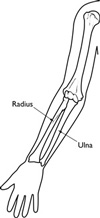
The forearm is made up of two bones: the radius and the ulna. The radius is on the "thumb side" of the forearm, and the ulna is on the "pinky finger side."
Growth plates are areas of cartilage near the ends of the long bones in children and adolescents. The long bones of the body do not grow from the center outward. Instead, growth occurs at each end of the bone around the growth plate. When a child is fully grown, the growth plates harden into solid bone. Both the radius and the ulna have growth plates.
DescriptionFractures can occur in one or both bones of the forearm, and in a number of places along the bone:
- Near the wrist, at the farthest (distal) end of the bone
- In the middle of the forearm
- Near the elbow, at the top (proximal) end of the bone
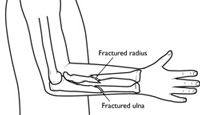 Fractures of both bones in the forearm.
Fractures of both bones in the forearm.
There are several types of forearm fractures in children:
- Torus fracture. This is also called a "buckle" fracture. The topmost layer of bone on one side of the bone is compressed, causing the other side to bend away from the growth plate. This is a stable fracture, meaning that the broken pieces of bone are still in position and have not separated apart (displaced).
- Metaphyseal fracture. The fracture is across the upper or lower portion of the shaft of the bone and does not affect the growth plate.
- Greenstick fracture. The fracture extends through a portion of the bone, causing it to bend on the other side.
- Galeazzi fracture. This injury affects both bones of the forearm. There is usually a displaced fracture in the radius and a dislocation of the ulna at the wrist, where the radius and ulna come together.
- Monteggia fracture. This injury affects both bones of the forearm. There is usually a fracture in the ulna and the top (head) of the radius is dislocated. This is a very severe injury and requires urgent care.
- Growth plate fracture. Also called a "physeal" fracture, this fracture occurs at or across the growth plate. In most cases, this type of fracture occurs in the growth plate of the radius near the wrist. Because the growth plate helps determine the future length and shape of the mature bone, this type of fracture requires prompt attention.
Children love to run, hop, skip, jump and tumble, all of which are activities that could potentially result in a fracture to the forearm should an unexpected fall occur. In most cases, forearm fractures in children are caused by:
- A fall onto an outstretched arm
- A fall directly on the forearm
- A direct blow to the forearm
A forearm fracture usually results in severe pain. Your child's forearm and hand may also feel numb, a sign of potential nerve injury.
Doctor ExaminationPhysical Examination
After discussing your child's symptoms and medical history, your doctor will perform a careful examination of your child's arm to determine the extent of the injury. He or she will look for:
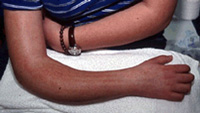 This child's forearm fracture has resulted in a bent appearance of the forearm.
(Courtesy of Texas Scottish Rite Hospital for Children)
This child's forearm fracture has resulted in a bent appearance of the forearm.
(Courtesy of Texas Scottish Rite Hospital for Children)
- Deformity about the elbow, forearm, or wrist
- Tenderness
- Swelling
- An inability to rotate or turn the forearm
During the physical examination, your doctor will also test to make sure that the nerves and circulation in your child's hand and fingers have not been affected.
X-Rays
X-rays provide clear images of dense structures such as bones. Because the hand, wrist, arm, and elbow can all be injured during a fall on an outstretched arm, your doctor may order x-rays of the elbow and wrist, as well as the forearm, to determine the extent of the injury.
TreatmentTreatment for forearm fractures depends on the type of fracture and the degree of displacement. Your doctor will use one of the following treatments, or a combination of both, to treat a forearm fracture.
Nonsurgical Treatment
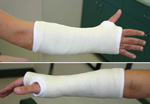 Casts support and protect broken bones while they heal.
Reproduced from Pring M, Chambers H: Pediatric forearm fractures. Orthopaedic Knowledge Online Journal 2007; 5(5). Accessed October 2014.
Casts support and protect broken bones while they heal.
Reproduced from Pring M, Chambers H: Pediatric forearm fractures. Orthopaedic Knowledge Online Journal 2007; 5(5). Accessed October 2014.
Some stable fractures, such as buckle fractures, may simply need the support of a cast or splint while they heal.
For more severe fractures that have become angled, the doctor may be able to manipulate or gently push the bones into place without surgery. This procedure is called a closed reduction. Afterward, the arm is immobilized in a cast or splint while it heals.
Surgical Treatment
In some cases, surgery is needed to align the pieces of bone and secure them in place. Your doctor may recommend surgery if:
- The bone has broken through the skin—this type of injury (called an open fracture) is at risk for infection and requires specific treatment
- The fracture is unstable—the ends of the broken
bones will not stay lined up - Bone segments have been displaced
- The bones cannot be aligned properly through manipulation alone
- The bones have already begun to heal at an angle or in an improper position
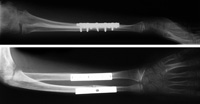 In these x-rays, fractures in both the radius and the ulna have been repaired with plates and screws.
Reproduced from Pring M, Chambers H: Pediatric forearm fractures. Orthopaedic Knowledge Online Journal 2007; 5(5). Accessed October 2014.
In these x-rays, fractures in both the radius and the ulna have been repaired with plates and screws.
Reproduced from Pring M, Chambers H: Pediatric forearm fractures. Orthopaedic Knowledge Online Journal 2007; 5(5). Accessed October 2014.
During surgery, your doctor will open the skin and reposition the broken bone fragments (a procedure called an open reduction). Your doctor may use pins, metal implants, or a cast to hold the broken bones in place until they have healed.
RecoveryThe length of time the cast is worn will vary depending on the severity of the fracture. A stable fracture, such as a buckle fracture, may require 3 to 4 weeks in a cast. A more serious injury, such as a Monteggia fracture, may need to be immobilized for 6 to 10 weeks.
When the cast is removed, the wrist and elbow joints may be stiff for 2 to 3 weeks. This stiffness will go away on its own, without the need for physical therapy.
For a time, the forearm bones may be weaker due to immobilization in the cast. To allow the bones to safely regain their normal strength, the child should avoid playing on playground structures, such as monkey bars, for 3 to 4 weeks after the cast is removed.
If the fracture disrupts the growth plate at the end of the bone, it could affect the development of the bone. Your doctor may recommend follow-up visits for up to one year to ensure that growth is proceeding normally.
Statistical data in this article was reviewed by the AAOS Department of Research and Scientific Affairs.
Source: http://orthoinfo.aaos.org/topic.cfm?topic=A00039
